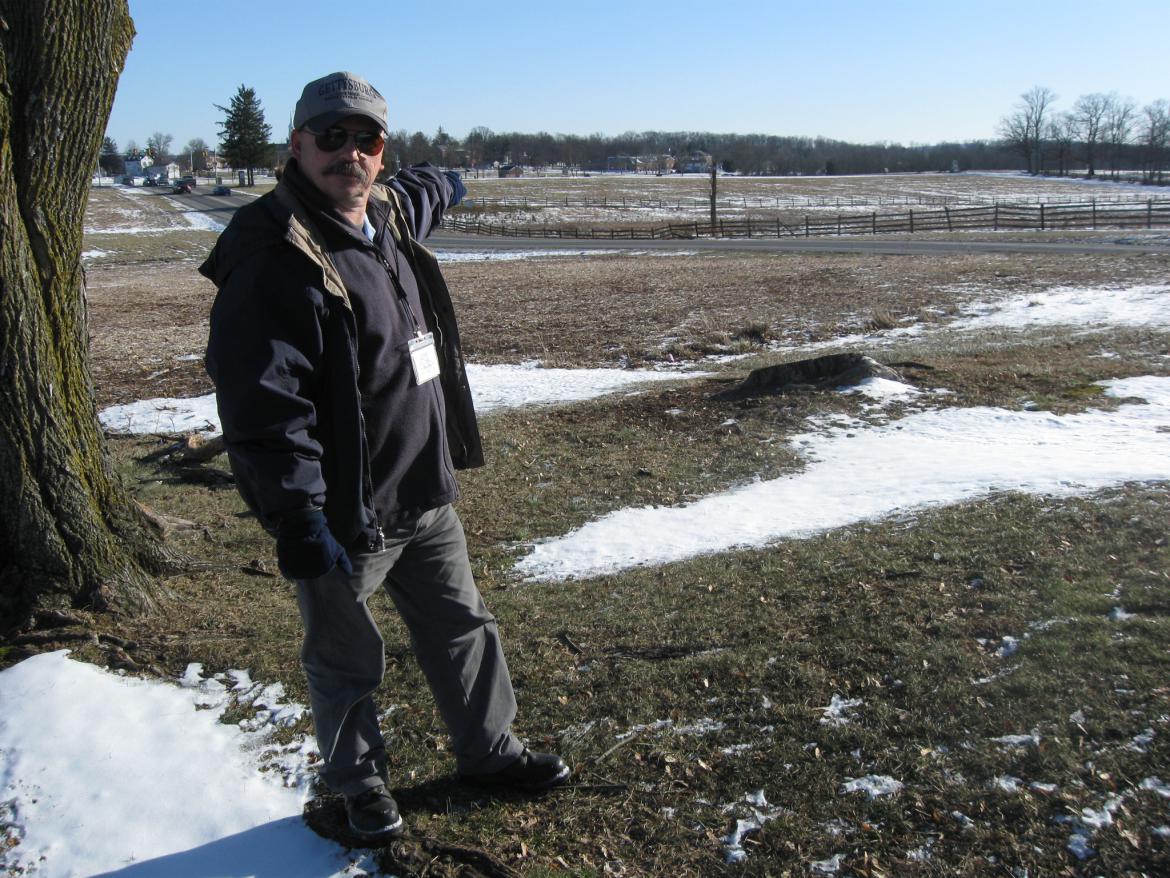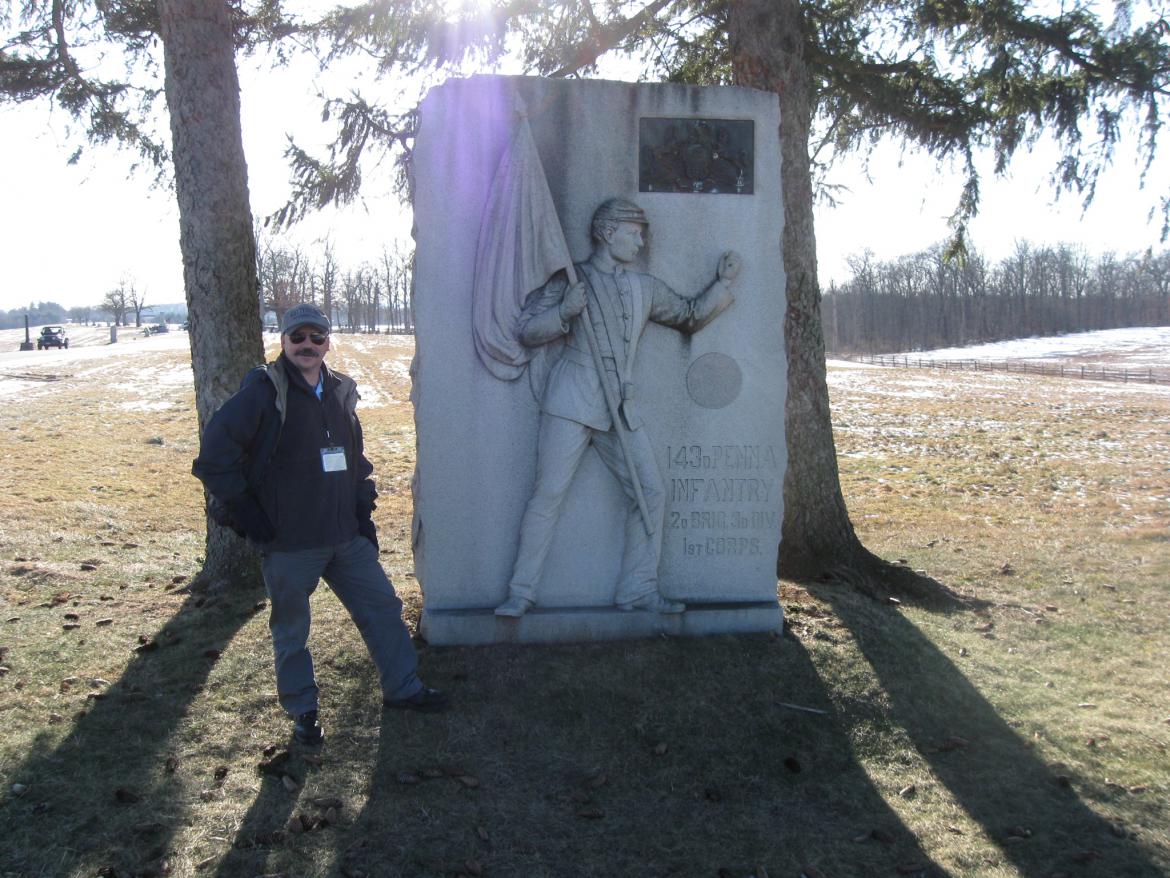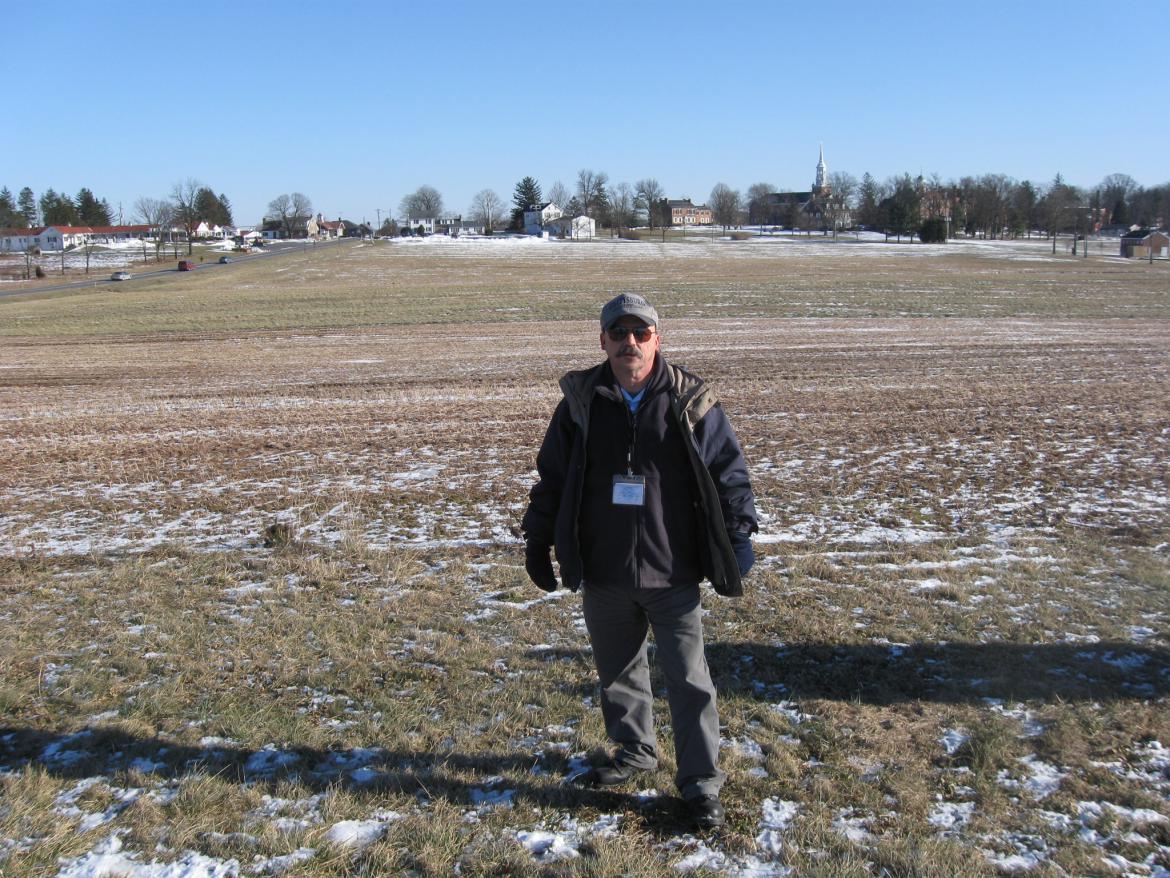Sergeant Henry Brehm was responsible for the United States’ Colors, or National Colors of the 149th Pennsylvania Infantry Regiment at the Battle of Gettysburg. This view, courtesy of Rich Kohr, was taken circa the 1860s.
In today’s Bucktails post, Gettysburg Licensed Battlefield Guide Rich Kohr describes how the National colors of the 149th Pennsylvania Infantry were captured, presents the story of Benjamin Crippen of the 143rd Pennsylvania, and shows the final Bucktail, Seminary Ridge positions on July 1, 1863.
This map shows the locations where our videos were recorded. The number in the star matches the number of the video listed on this post. Video #10 was taken by the monument to the 150th Pennsylvania Infantry Regiment. Video #11 was taken farther down the slope of McPherson’s Ridge overlooking Willoughby Run and the Willoughby Run Quarry. Video #12 was taken between the monument to the 150th Pennsylvania and the McPherson Barn. Video #13 was taken east of the McPherson Barn. Video #14 was taken at the south side of the McPherson Barn. Video #15 was taken on the south side of the Chambersburg Pike. Videos #16-#18 were taken near the location of the colors of the 149th Pennsylvania Infantry Regiment. Video #19 was taken behind (east of) the equestrian statue to Major General John F. Reynolds. Video #20 was taken at the intersection of Reynolds Avenue and the Chambersburg Pike at the monument to the 143rd Pennsylvania Infantry Regiment. Video #21 was taken on East McPherson’s Ridge, east of Reynolds Avenue, near the Chambersburg Pike. This map was made facing north at approximately 10:00 AM on Wednesday, February 10, 2010.
Gettysburg Licensed Battlefield Guide Rich Kohr is standing behind (east of) the equestrian monument to Major General John F. Reynolds. He is pointing in the direction by which the Color Bearer and Color Guard for the National Colors of the 149th Pennsylvania attempted to flee on July 1, 1863. This view was taken facing southeast at approximately 2:30 PM on Sunday, January 10, 2010.
In Video #19 (Videos #1-#18 were shown in our previous Bucktail posts) Gettysburg Licensed Battlefield Guide Rich Kohr describes the fight for the National Colors of the 149th Pennsylvania Infantry Regiment. This view was taken facing northwest to southeast at approximately 2:30 PM on Sunday, January 10, 2010.
Corporal John Friddell was a member of the Color Guard for the 149th Pennsylvania Infantry Regiment. On July 1, 1863, he and John Hammel, purposely attracted fire towards themselves in order to draw fire away from Color Bearer Henry Brehm. Friddell was shot through the lung, but survived. Hammel died of his stomach wound in September, 1863. This view, courtesy of Rich Kohr, was taken circa the 1860s.
Licensed Battlefield Guide Rich Kohr has now moved to the junction of the Chambersburg Pike and Reynolds Avenue. He is standing by the monument to the 143rd Pennsylvania Infantry Regiment, which features their color bearer, Benjamin Crippen. This view was taken facing southwest at approximately 2:30 PM on Sunday, January 10, 2010.
In Video #20 Licensed Battlefield Guide Rich Kohr describes the actions of Color Sergeant Benjamin Crippen of the 143rd Pennsylvania Infantry Regiment. This view was taken facing southwest to west to east at approximately 2:30 PM on Sunday, January 10, 2010.
Color Sergeant Benjamin Crippen was a member of Company E of the 143rd Pennsylavnia. He enlisted on September 6, 1862 was 6′ 1″ in height. His death was described in a British publication. Lieutenant Colonel Arthur Freemantle from Britain’s Coldstream Guards recalled in Blackwood’s Magazine a conversation that he had with Confederate Lieutenant General A.P. Hill following the July 1, 1863 fighting. Hill told Fremantle that “the Yankees had fought with a determination unusual to them. He (Hill) pointed out a railway cutting in which they had made a good stand; also a field in the centre of which he had seen a man plant the regimental colors, round which the enemy had fought for some time and with much obstinacy, and when at last it was obliged to retreat, the color bearer retired last of all, turning round every now and then to shake his fist at the advancing rebels. General Hill said he had felt quite sorry when he had seen this gallant Yankee meet his doom. The flag was rescued and brought safely off.” This view, courtesy of Rich Kohr, was taken circa the 1860s.
Rich Kohr is now standing on East McPherson’s Ridge, east of Reynolds Avenue. In the background on Seminary Ridge from left to right is: Mary Thompson House, just left (north) of the Chambersburg Pike; James Thompson House, just right (south) of the Chambersburg Pike; postwar white building; red brick Krauth House, built circa 1834; Seminary Chapel with white steeple, built 1942, and a post Civil War structure below it; the cupola shown above the trees is on the Civil War Seminary main building, now known as Schmucker Hall. This view was taken facing east at approximately 2:30 PM on Sunday, January 10, 2010.
In Video #21 Rich Kohr is standing on East McPherson’s Ridge, east of Reynolds Avenue. He describes the final positions for the Bucktails on Seminary Ridge. This view was taken facing east to northeast to southeast at approximately 2:30 PM on Sunday, January 10, 2010.







